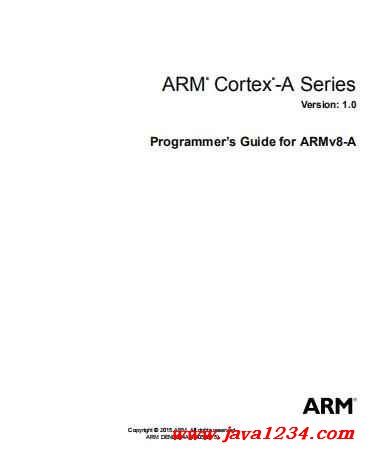| 澶辨晥閾炬帴澶勭悊 |
|
ARM Cortex-A(armV8)緙栫▼鎵嬪唽 PDF 涓嬭澆
鏈珯鏁寸悊涓嬭澆錛?/strong>
閾炬帴錛?a target="_blank">https://pan.baidu.com/s/1lE_f8ILSKE9Hh2Ary5WruQ
鎻愬彇鐮侊細(xì)nsx6
鐩稿叧鎴浘錛?/strong>

涓昏鍐呭錛?/strong>
Preface
In 2013, ARM released its 64-bit ARMv8 architecture, the first major change to the ARM
architecture since ARMv7 in 2007, and the most fundamental and far reaching change since the
original ARM architecture was created.
Development of the architecture has continued for some years. Early versions were being used
before the Cortex-A Series Programmer’s Guide for ARMv7-A was first released. The first of
the Programmer’s Guide series from ARM, it post-dated the introduction of the 32-bit ARMv7
architecture by some years. Almost immediately there were requests for a version to cover the
ARMv8 architecture. It was intended from the outset that a guide to ARMv8 should be available
as soon as possible.
This book was started when the first versions of the ARMv8 architecture were being tested and
codified. As always, moving from a system that is known and understood to something new and
unknown can present a number of problems. The engineers who supplied information for the
present book are, by and large, the same engineers who supplied the information for the original
Cortex-A Series Programmer’s Guide. This book has been made richer by their observations and
insights as they use, and solve the problems presented by the new architecture.
The Programmer’s Guides are meant to complement, rather than replace, other ARM
documentation available, such as the Technical Reference Manuals (TRMs) for the processors
themselves, documentation for individual devices or boards or, most importantly, the ARM
Architecture Reference Manual (the ARM ARM). They are intended to provide a gentle
introduction to the ARM architecture, and cover all the main concepts that you need to know
about, in an easy to read format, with examples of actual code in both C and assembly language,
and with hints and tips for writing your own code.
It might be argued that if you are an application developer, you do not need to know what goes
on inside a processor. ARM Application processors can easily be regarded as black boxes which
simply run your code when you say go. Instead, this book provides a single guide, bringing
Preface
ARM DEN0024A Copyright © 2015 ARM. All rights reserved. viii
ID050815 Non-Confidential
together information from a wide variety of sources, for those programmers who get the system
to the point where application developers can run applications, such as those involved in ASIC
verification, or those working on boot code and device drivers.
During bring-up of a new board or System-on-Chip (SoC), engineers may have to investigate
issues with the hardware. Memory system behavior is among the most common places for these
to manifest, for example, deadlocks where the processor cannot make forward progress because
of memory system lock. Debugging these problems requires an understanding of the operation
and effect of cache or MMU use. This is different from debugging a failing piece of code.
In a similar vein, system architects (usually hardware engineers) make choices early in the
design about the implementation of DMA, frame buffers and other parts of the memory system
where an understanding of data flow between agents in required. In this case it is difficult to
make sensible decisions about it if you do not understand when a cache will help you and when
it gets in the way, or how the OS will use the MMU. Similar considerations apply in many other
places.
This is not an introductory level book, nor is it a purely technical description of the architecture
and processors, which merely state the facts with little or no explanation of ‘how’ and ‘why’.
ARM and all who have collaborated on this book hope it successfully navigates between the two
extremes, while attempting to explain some of the more intricate aspects of the architecture.
Preface
ARM DEN0024A Copyright © 2015 ARM. All rights reserved. ix
ID050815 Non-Confidential
Glossary
Abbreviations and terms used in this document are defined here.
AAPCS ARM Architecture Procedure Call Standard.
AArch32 state The ARM 32-bit execution state that uses 32-bit general-purpose registers,
and a 32-bit Program Counter (PC), Stack Pointer (SP), and Link Register
(LR). AArch32 execution state provides a choice of two instruction sets,
A32 and T32, previously called the ARM and Thumb instruction sets.
AArch64 state The ARM 64-bit execution state that uses 64-bit general-purpose registers,
and a 64-bit Program Counter (PC), Stack Pointer (SP), and Exception
Link Registers (ELR). AArch64 execution state provides a single
instruction set, A64.
ABI Application Binary Interface.
ACE AXI Coherency Extensions.
AES Advanced Encryption Standard.
AMBA® Advanced Microcontroller Bus Architecture.
AMP Asymmetric Multi-Processing.
ARM ARM The ARM Architecture Reference Manual.
ASIC Application Specific Integrated Circuit.
ASID Address Space ID.
AXI Advanced eXtensible Interface.
BE8 Byte Invariant Big-Endian Mode.
BTAC Branch Target Address Cache.
BTB Branch Target Buffer.
CCI Cache Coherent Interface.
CHI Coherent Hub Interface.
CP15 Coprocessor 15 for AArch32 and ARMv7-A- System control coprocessor.
DAP Debug Access Port.
DMA Direct Memory Access.
DMB Data Memory Barrier.
DS-5™ The ARM Development Studio.
DSB Data Synchronization Barrier.
DSP Digital Signal Processing.
DSTREAM An ARM debug and trace unit.
DVFS Dynamic Voltage/Frequency Scaling.
EABI Embedded ABI.
ECC Error Correcting Code.
Preface
ARM DEN0024A Copyright © 2015 ARM. All rights reserved. x
ID050815 Non-Confidential
ECT Embedded Cross Trigger.
EL0 Exception level used to execute user applications.
EL1 Exception level normally used to run operating systems.
EL2 Hypervisor Exception level. In the Normal world, or Non-Secure state,
this is used to execute hypervisor code.
EL3 Secure Monitor exception level.This is used to execute the code that
guards transitions between the Secure and Normal worlds.
ETB Embedded Trace Buffer™.
ETM Embedded Trace Macrocell™.
Execution state The operational state of the processor, either 64-bit (AArch64) or 32-bit
(AArch32).
FIQ An interrupt type (formerly fast interrupt).
FPSCR Floating-Point Status and Control Register.
GCC GNU Compiler Collection.
GIC Generic Interrupt Controller.
Harvard architecture
Architecture with physically separate storage and signal pathways for
instructions and data.
HCR Hyp Configuration Register.
HMP Heterogenous Multi-Processing.
IMPLEMENTATION DEFINED
Some properties of the processor are defined by the manufacturer.
IPA Intermediate Physical Address.
IRQ Interrupt Request, normally for external interrupts.
ISA Instruction Set Architecture.
ISB Instruction Synchronization Barrier.
ISR Interrupt Service Routine.
Jazelle™ The ARM bytecode acceleration technology.
LLP64 Indicates the size in bits of basic C data types. Under LLP64 int and long
data types are 32 bit, pointers and long long are 64 bits.
LP64 Indicates the size in bits of basic C data types. Under LP64 int types are
32 bits, all others are 64 bits.
LPAE Large Physical Address Extension.
LSB Least Significant Bit.
MESI A cache coherency protocol with four states that are Modified, Exclusive,
Shared and Invalid.
MMU Memory Management Unit.
|




 鑻忓叕緗戝畨澶?32061202001004鍙?/p>
鑻忓叕緗戝畨澶?32061202001004鍙?/p>


